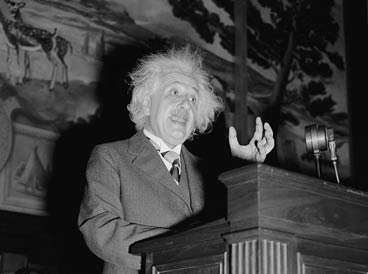Like psychoanalysis, autosuggestion, and the Lost Generation, relativity was one of those trendy terms everyone used in the 1920s but few understood.
The nation’s newspapers informed readers that relativity was a revolutionary idea that would change our understanding of the universe, but they were rarely able to explain any further.
“The meaning of relativity,” Einstein said in a 1929 interview with The Saturday Evening Post, “has been widely misunderstood. Philosophers play with the word, like a child with a doll. Relativity, as I see it, merely denotes that certain physical and mechanical facts, which have been regarded as positive and permanent, are relative with regard to certain other facts in the sphere of physics and mechanics. It does not mean that we have the right to turn the world mischievously topsy-turvy.” (Read the entire the interview here “What Life Means to Einstein: An Interview by George Sylvester Viereck”; October 26, 1929.)
And still Americans used the word for what they thought it should mean: Everything is relative. An act was only ‘good’ or ‘bad’ in relation to something else. There were no absolutes.
Hoping to correct this error, James R. Newman wrote an extensive article on Einstein’s theories for The Saturday Evening Post in 1959. “The statement that everything is relative is as meaningful as the statement that everything is bigger. As Bertrand Russell pointed out, if everything were relative there would be nothing for it to be relative to.
“The name relativity is misleading. Einstein was in fact concerned with finding something that is not relative, something that mathematicians call an invariant. With this as a fixed point, it might be possible to formulate physical laws which would incorporate the ‘objective residue’ of an observer’s experience; that is, that part of the space and time characteristics of a physical event which, though perceived by him, are independent of the observer and might therefore be expected to appear the same to all observers.” (See “Einstein’s Great Idea” by James R. Newman; May 16, 1959.)
Relativity reconciled the mechanical model of the physical world—as described by Isaac Newton—to a universe in which scientists could measure the distance of light years and the speed of electrons. He achieved this with a mathematical model that amended Newton’s claim that time was absolute, true, and flowed evenly without interference.
As shown in Einstein’s explanation, reproduced by Newman and printed in the Post, time did not ‘flow’ identically for two observers. Two events that appeared simultaneous to one person could appear sequential to another.
Einstein’s Own Example of the Relativity of Time
The diagram shows a long railroad train traveling along the rails with velocity (V), in the direction toward the right of the page.
The bottom line denotes the embankment running parallel to the rails.
The letters A and B mark two places on the rails, and the letter M marks a point on the embankment directly midway between A and B.
At M stands an observer equipped with a pair of mirrors that are joined in a “V” and inclined at 90 degrees. By means of this device he can observe both places, A and B, at the same time.
We imagine two events at A and B, say two flashes of lightning, which the observer perceives in his mirror device at the same time. These he pronounces to be simultaneous, by which he means that the rays of light emitted at A and at B by the lightning bolts meet at the midpoint M of the length A—> B along the embankment.
Now consider the moving train, and imagine a passenger seated in it.
As the train proceeds along the rails, the passenger will arrive at a point M1, which is directly opposite M, and therefore exactly midpoint between the length A —> B along the rails.
Assume further that the passenger arrives at M1 just when the flashes of lightning occur.
We have seen that the observer at M correctly pronounces the lighting bolts as simultaneous; the question is, will the train passenger at M1 make the same pronouncement? It is easily shown that he will not.
Obviously if the point M1 were stationary with respect to M, the passenger would have the same impression of simultaneity of the lightning flashes as the observer on the embankment. But M1 is not stationary; it is moving toward the right with the velocity (V) of the train.
Therefore (considered with reference to the embankment) the passenger is moving toward the beam of light coming from B, and away from the beam coming from A.
It seems clear then that he will see the beam emitted by the flash at B sooner than the beam emitted by the flash at A. Accordingly he will pronounce the flash at B as earlier in time than the flash at A.
Which of the two pronouncements is correct, the observer’s or the passenger’s?
The answer is that each is right in its own system. The observer is right with respect to the embankment, the passenger with respect to the train. The observer may say that he alone is right because he is at rest while the passenger is moving and his impressions are therefore distorted.
To this the passenger can reply that motion does not distort the signals, and that, in any case, there is no more reason to believe that he was moving and the observer at rest than that the passenger was at rest and the observer moving.
There is nothing to choose between these views, and they can be logically reconciled only by accepting the principle that simultaneity of events is meaningful only with respect to a particular reference system; moreover, that every such system has its own particular time, and unless, as Einstein says, we are told the reference system to which the statement of time refers, a bare statement of the time of an event is meaningless.
Did relativity profoundly change our lives, as the newspapers of the 1920s claimed? Not directly—unless you’re able to drive your car at the speed of light, in which case relativity would be a matter of infinite concern to you. But relativity did lead to other innovations, such as nuclear power and GPS.
So, you can live quite comfortably without understanding why energy = (mass) x (the speed of light squared). Just keep your speedometer under 186,282 miles per second and you’ll be fine.
Become a Saturday Evening Post member and enjoy unlimited access. Subscribe now





Comments
Einstein ‘splained relativity
Of time, using two points of view
Of two guys – one standing near be
A moving train. The other who
Is on that train, sees lightning bolts
In two spots, sequentially hit.
The other guy on the ground jolts,
Seeing two flashes same time lit.
Why did the guys not see the same?
The difference ’twas motion made,
As Einstein tried to ‘splain his claim,
With two guys in visual aid.
Relativity’s hard to ‘splain
To a guy just hit by a train.
The example given in this article about relativity is interesting, but I do not yet really understand the meaning of relativity. Maybe it’s just me, but I still need a definite meaning of relativity. Sorry!
Evelyn Long
absolutely love the saturday evening post.thank you so much